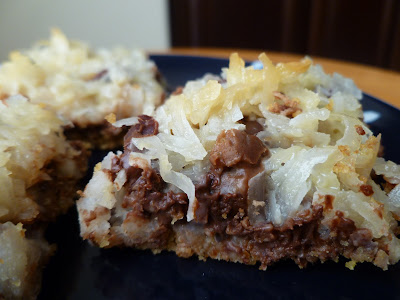The Most Amazing Chocolate Cake - made October 2, 2017 from
The Stay at Home Chef
I'm moving this up in the blogging order because I made this cake this week for a work potluck and had several requests for the recipe. Normally I bake 2-3 weeks ahead of when I post something but if I'm asked for the recipe, I try to accommodate sooner than later.
Typically, for potlucks, I try to bring something easy to serve and eat, usually cookies, brownies or easy-to-portion sheet cakes. They're easy to make and you can make the individual portions small so people can eat as much or as little as they want. For this potluck, I went off the beaten path in making this triple layer chocolate cake. I don't usually make cakes in three layers because even a small slice can be so intimidating to eat. But from a visual perspective, I have to admit, few things wow as much as three layers of cake and frosting, especially if both cake and frosting are chocolate.


This definitely has the wow factor, even hampered by my less-than-stellar (non) decorating skills when it comes to cakes. The batter is a bit thin which past experience tells me means this cake is likely to come out moist with a soft crumb. And so it did. When using this much cocoa, you also want to make sure the cake has a lot of liquid since cocoa is a drying agent. Between the buttermilk, water and oil, this definitely has the moisture factor.
If you want a dark, rich chocolate cake, you must use a dark, rich cocoa powder. That's where the chocolate flavor comes from and if you use a subpar or tepid cocoa, your cake won't have that chocolate punch. I (always) use Pernigotti cocoa but you can also use Valrhona, Scharffenberger or other high end cocoas. Some bloggers recommend Hershey's Dark; I've never tried it myself so I can't speak to it but I'm not going to lie. I'm a baking ingredient snob so Hershey's doesn't usually cut it for me.

The original recipe calls for baking the cake in three 9" round cake tins. I baked this in three 8" round cake tins and used the leftover batter for 6 cupcakes. You can go with 9" rounds but if you do 8", don't try to use all the batter in the 8" rounds. It'll make your cake too high when the layers are stacked up and you risk the batter overflowing the cake pans if you fill them too much before baking. I never time cakes but go by the toothpick test. Poke the toothpick near the center and if it comes out with a few crumbs or clean, take them out. I prefer a few moist crumbs rather than completely clean but you can also use the touch test; if the cake springs back when lightly pressed near the center, it's done.


The frosting recipe makes a fair amount of frosting. My usual error in frosting multi-layer cakes is I get paranoid I won't have enough frosting so I skimp on the frosting between the layers and end up with too much leftover frosting at the end which I try to use by plastering the sides and top. This time, I estimated (fairly) correctly and got enough between the layers. I had enough frosting leftover to frost the extra cupcakes as well as make a half-assed attempted to decorate the bottom of the cake with random "stars". Just don't look too closely at them in the pictures.
To cut some of the dark chocolate richness and provide a little texture, I sprinkled the top with milk chocolate toffee bits. It made for a decent presentation but it's okay to leave this plain if you don't like toffee or you know your cake eaters have nut allergies. You can also sprinkle crushed Oreos on top or drizzle caramel.
I liked this cake. It was rich, it was moist, it was chocolaty. I don't know that I would bake it other than for a large group gathering. Slicing thin slices is a bit tricky with so many layers and it got messy when I was trying to cut the last chunk. But the taste will compensate for the appearance if you can't make perfect slices.
butter and flour for coating and dusting the cake pans
3 cups (450 g) all-purpose flour
3 cups (650 g) granulated sugar
1 1/2 cups (155 g) unsweetened cocoa powder
1 tablespoon baking soda
1 1/2 teaspoons baking powder
1 1/2 teaspoons salt
4 large eggs
1 1/2 cups buttermilk
1 1/2 cups warm water
1/2 cup vegetable oil
2 teaspoons vanilla extract
Chocolate Cream Cheese Buttercream Frosting
1 1/2 cups butter, softened
8 ounces cream cheese, softened
1 1/2 cups unsweetened cocoa powder
3 teaspoons vanilla extract
7-8 cups powdered sugar
about 1/4 cup milk, as needed
- Preheat oven to 350 degrees. Butter three 9-inch cake rounds. Dust with flour and tap out excess. Line bottoms with parchment rounds, optional but recommended.
- Mix together flour, sugar, cocoa, baking soda, baking powder and salt in a stand mixer on low speed until combined.
- Add eggs, buttermilk, warm water, oil and vanilla. Beat on medium speed until smooth, about 2 minutes.
- Divide batter evenly among the three pans. Bake for 30-35 minutes or until a toothpick inserted near the center of each round comes out with a few moist crumbs, not raw batter.
- Cool on wire racks for 10 minutes then turn the cakes onto the racks and allow to cool completely.
- While cakes are cooling, make frosting: in a large bowl, beat together the butter and cream cheese until fluffy.
- Add the cocoa powder and vanilla extract; beat until combined.
- Beat in powdered sugar, one cup at a time. Add milk as needed to make a spreadable consistency.

















































